Staying safe in smoky conditons

Holy smokes! It’s pretty smoky outside! As it begins to appear like not only will 2020 have a fire season, but given the lack of containment on these wildfires, we might be in for more than just a couple days of poor air quality. This also may become more of the norm, as this isn’t the first year we’ve had to endure smoky days and weeks. It’s easy enough to keep ourselves indoors, but it’s not as easy for some pets to comfortably stay inside all day! Since we at Frolic love your pets and ours, and want them to be as comfortable as possible for as long as the smoke hangs around, we’ve got a few tips to keep your pet safe.
Obviously, the best thing you can do for them is to remain indoors. It feels like it should go without saying, but just in case—be sure all windows are closed. If you’re lucky enough to have air conditioning, it’s time to turn it on, to keep the indoor air from getting too stagnant. Potty breaks should be kept short. If your pet is like some of ours and just likes to wander around the backyard at various points of the day, don’t be afraid to bring them in without going and try again later—when they really have to go, they’ll take the opportunity. Hydration is always important, but it’s even more important in these conditions. Be sure to encourage your pup to drink water after even short trips outside.
For dog owners, be sure to recognize if yours is a breed that is especially susceptible to breathing problems. Flat-nosed dogs like pugs and bulldogs, for instance. Just like these conditions are harder on our children and grandparents, puppies and senior dogs are also more vulnerable to smoke. Also, if your dog has a respiratory condition like asthma, they are also at higher risk. Here’s a link to an example of a mask made specifically for dogs.
Poor air quality is a serious problem for many dogs, and it’s always better to take warning signs seriously. If your pet has difficulty breathing, swelling in the face or mouth, excessive & continued panting, decreased motor skills or an inability to stand up, coughing or vomiting, or loss of appetite, you should not hesitate to take your pet to the vet.
Being cooped up inside is tough on our pets, though. Pups may struggle to understand why they can’t come and go as they please from the backyard as normal. Many are also used to different levels of outdoor activities so it’s easy for them to get anxious about the sudden routine change. You may have to do some encouraging, but there are activities you can do indoors to try to keep them close to their normal level of activity. That might just mean playing more fetch, getting creative with feeding or using a puzzle treat toy to keep them occupied mentally for a moment. It’s also a good opportunity to teach your dog new tricks, or just go over and reinforce some basic training.
While there are ways to mitigate outside danger, truly the best way to make sure they’re safe with AQI levels approaching a “hazardous” definition is to keep them inside as much as possible. They may get annoyed with you or anxious to go outside, but it’s better for their health, and yours. We’ve included a link to the AirNow. gov site, where you can check out local air quality all year long. Your family becomes our family, so making sure we’re safe and responsible with them in these unexpected conditions is our number one priority! Stay safe, friends!